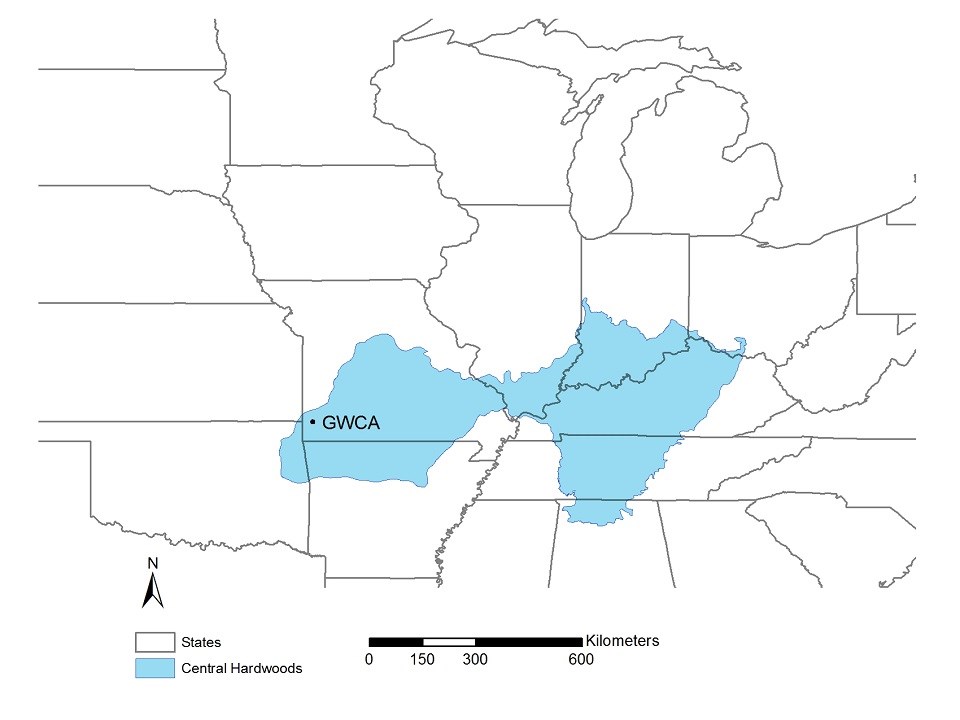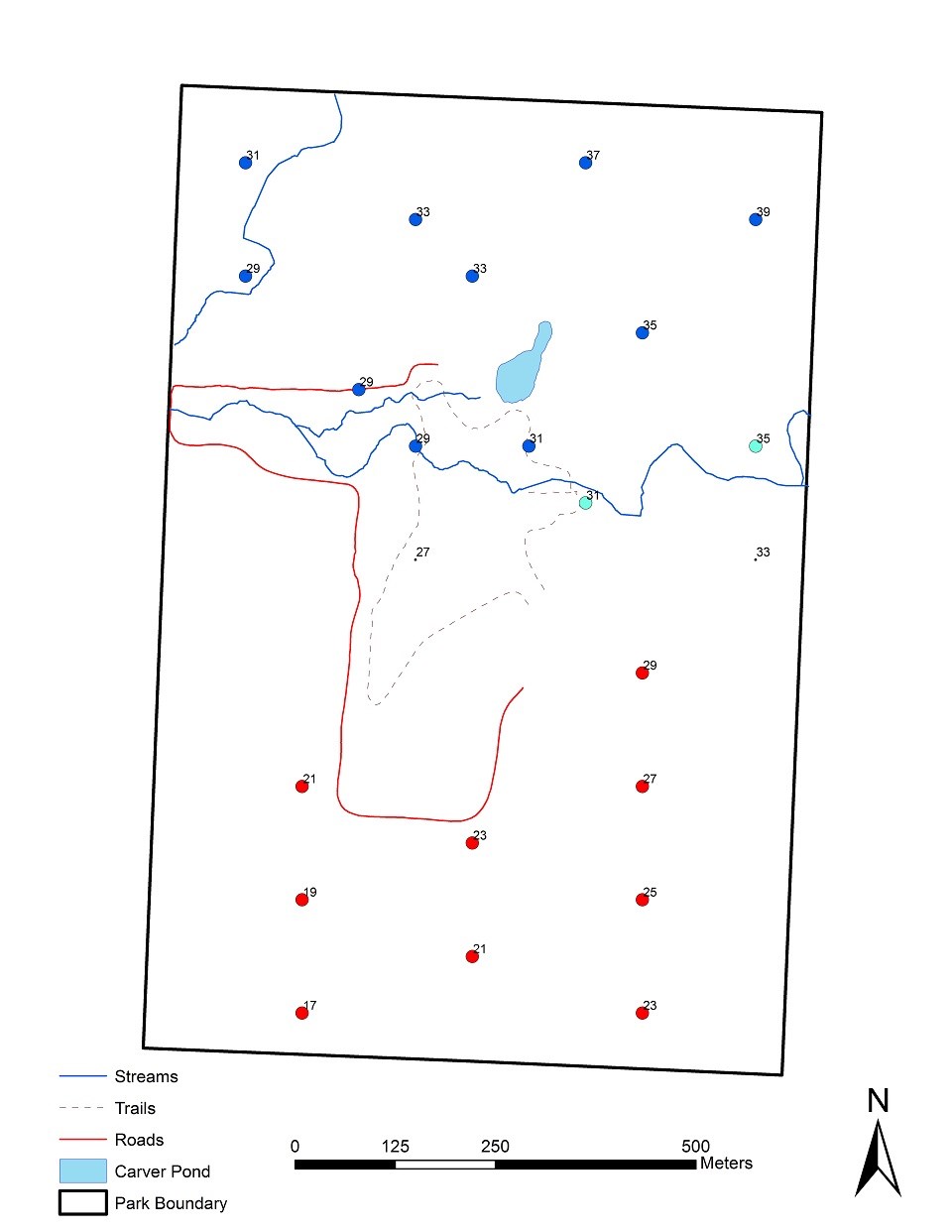Last updated: October 8, 2020
Article
Volunteer Bird Monitoring at George Washington Carver National Monument
Birds are an important part of the world we live in. They eat pests, spread seeds, pollinate plants, feed us, and provide enjoyment. And, they are beautiful, flying creatures. Who hasn’t wanted to soar like a bird at one time or another? Birds are a significant component of park ecosystems. Their habitat requirements and diverse diets make birds good indicators of changes in an ecosystem – the canary in the coal mine, so to speak. But, many grassland and woodland birds are declining in number. There are many reasons, such as habitat loss, global warming, wind turbines, and cats.
We track the types and numbers of birds that nest in national parks to determine the health of bird communities. We do this by surveying birds during the breeding season. We also characterize their habitat. For example, the amount of forest and grassland, and vegetation structure. Over time, we look for trends in the community. For context, we compare our findings to trends in the region. Long-term population trends in the bird community help us to assess the quality and sustainability of park ecosystems.
We track the types and numbers of birds that nest in national parks to determine the health of bird communities. We do this by surveying birds during the breeding season. We also characterize their habitat. For example, the amount of forest and grassland, and vegetation structure. Over time, we look for trends in the community. For context, we compare our findings to trends in the region. Long-term population trends in the bird community help us to assess the quality and sustainability of park ecosystems.

NPS
Methods:
For details on methods of bird surveys see Peitz et al. (2008).- Bird communities were monitored at 23 points by David R. Henness and Lydia E. O’Donnell, between June 9th and June 15th.
- All birds seen or heard in a 5-minute sampling period at each plot were recorded.
- Residency status of each species was established prior to analysis of the data (Robbins and Easterla 1992).
- Using hot-spot-analysis in ArcGIS, areas of higher and lower species richness on the monument were determined.
- Calculated number of individuals encountered per plot visit, and proportion of plots occupied by a species.

NPS
Summary of Findings:
- Thirty-seven bird species were observed during surveys. All 37 species are resident or summer resident species thus considered breeding species at GWCA (Table 1).
- The most commonly occurring and widespread bird on GWCA is the Dickcissel.
- Bell’s Vireo is a species of conservation concern for the Central Hardwoods Bird Conservation Region (Figure 1).
- Hot-spot-analysis showed areas with concentrations of plots with high and others with low species richness on GWCA (Figure 2).
Common name |
Residency1 |
Individuals / plot visit |
Proportion of plots occupied |
| Acadian Flycatcher | SR | 0.04 | 0.04 |
| American Crow | R | 0.26 | 0.17 |
| American Goldfinch | R | 0.43 | 0.17 |
| American Robin | R | 0.04 | 0.04 |
| Baltimore Oriole | SR | 0.09 | 0.09 |
| Barn Swallow | SR | 0.30 | 0.13 |
| Bell’s Vireo | SR | 0.04 | 0.04 |
| Blue Jay | R | 0.39 | 0.35 |
| Blue-gray Gnatcatcher | SR | 0.13 | 0.09 |
| Brown-headed Cowbird | R | 0.39 | 0.17 |
| Blue Grosbeak | SR | 0.09 | 0.04 |
| Brown Thrasher | R | 0.04 | 0.04 |
| Carolina Wren | R | 0.52 | 0.39 |
| Common Grackle | R | 0.04 | 0.04 |
| Common Yellowthroat | SR | 0.30 | 0.26 |
| Dickcissel | SR | 2.13 | 0.70 |
| Eastern Bluebird | R | 0.26 | 0.17 |
| Eastern Meadowlark | SR | 0.13 | 0.09 |
| Eastern Phoebe | R | 0.04 | 0.04 |
| Eastern Wood-pewee | SR | 0.30 | 0.26 |
| Field Sparrow | R | 0.30 | 0.30 |
| Indigo Bunting | SR | 0.48 | 0.43 |
| Mourning Dove | R | 0.17 | 0.17 |
| Northern Bobwhite | R | 0.13 | 0.13 |
| Northern Cardinal | R | 0.61 | 0.48 |
| Northern Mockingbird | R | 0.09 | 0.09 |
| Northern Parula | SR | 0.13 | 0.13 |
| Pileated Woodpecker | R | 0.04 | 0.04 |
| Red-bellied Woodpecker | R | 0.30 | 0.30 |
| Red-shouldered Hawk | R | 0.09 | 0.04 |
| Red-tailed Hawk | R | 0.04 | 0.04 |
| Red-winged Blackbird | R | 0.04 | 0.04 |
| Scissor-tailed Flycatcher | SR | 0.17 | 0.09 |
| Tufted Titmouse | R | 0.61 | 0.39 |
| Turkey Vulture | R | 0.13 | 0.04 |
| Yellow-breasted Chat | SR | 0.09 | 0.09 |
| Yellow-billed Cuckoo | SR | 0.39 | 0.35 |
1 Residency status: R = year around resident; SR = summer resident (Robbins and Easterla 1992).
* Denotes species only recorded outside the 5-min survey period.
Bolded species names are those species considered of conservation concern for the Central Hardwoods Bird Conservation Region (U.S. Fish and Wildlife Service 2008).
Visit the Datastore to download the full report.
Learn more about the Heartland Inventory & Monitoring Network.
Data in this report were collected and analyzed using methods based on established, peer-reviewed protocols and were analyzed and interpreted within the guidelines of the protocols.
Data for year 2018 have undergone quality control and certification, but not previously published.
